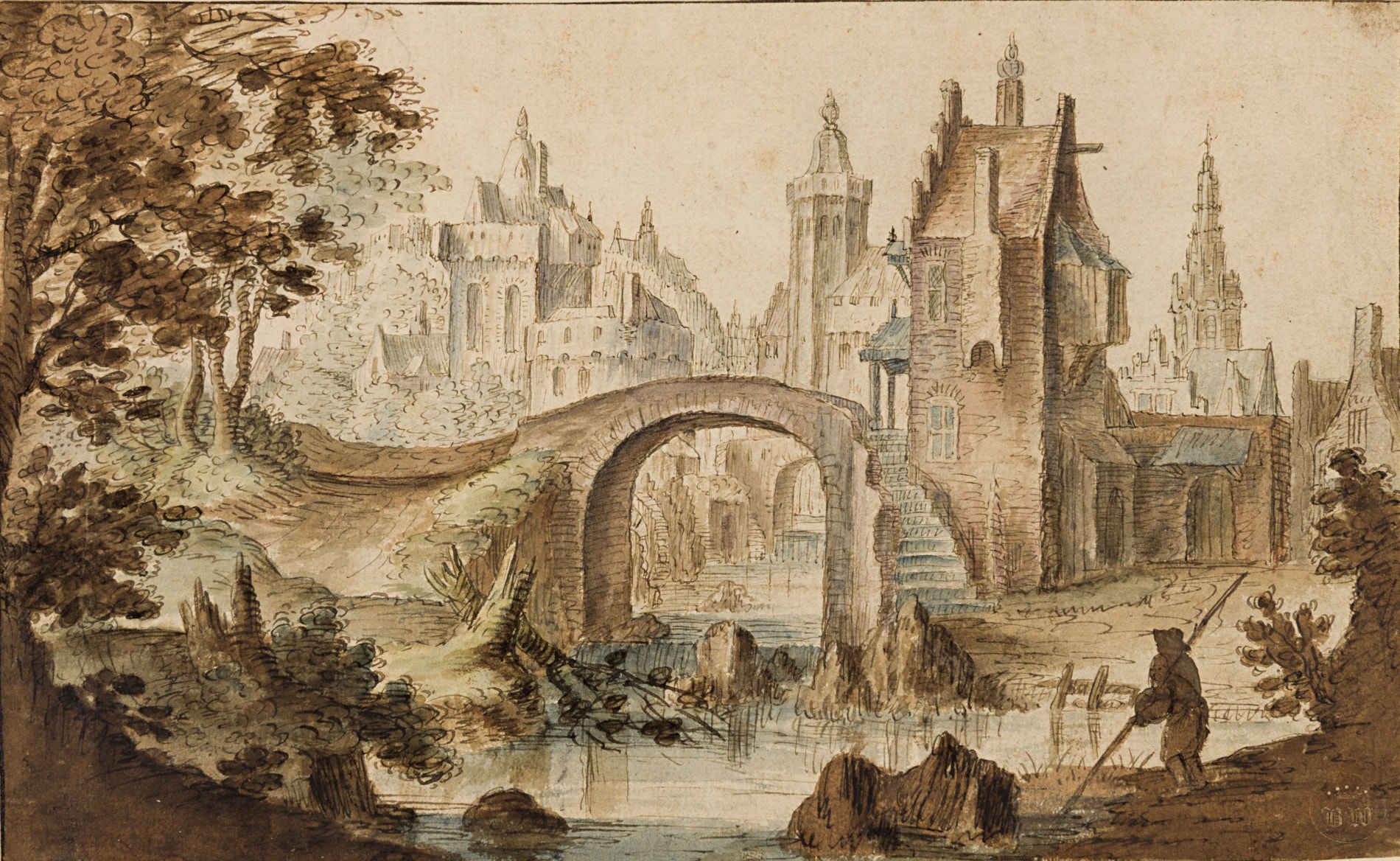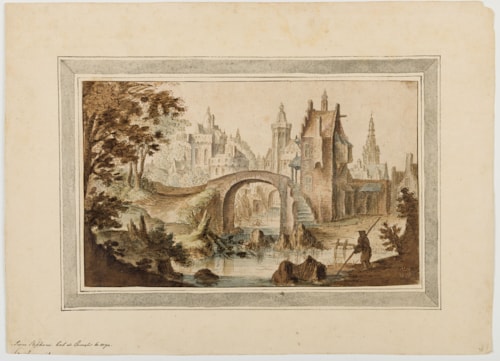c.1600 FLEMISH SCHOOL
Landscape with a Town and Bridge
Sold
Pen and brown ink and brown wash and watercolour, with framing lines in brown ink.
Made up at the upper right corner.
Inscribed Petrus Stephanus and numbered 57 on the verso.
Further inscribed Pierre Stephane. Col de Spengler No. 1094. on the old mount.
190 x 309 mm. (7 1/2 x 12 1/8 in.)
Made up at the upper right corner.
Inscribed Petrus Stephanus and numbered 57 on the verso.
Further inscribed Pierre Stephane. Col de Spengler No. 1094. on the old mount.
190 x 309 mm. (7 1/2 x 12 1/8 in.)
The present sheet has long been attributed to the Flemish landscape artist Pieter Stevens the Younger (c.1567-1624). Stevens is thought to have trained in Antwerp, where he is documented as an independent master in 1589, and may have visited Italy between 1590 and 1591, based on some drawings of Italian views, but this remains conjectural. (If he had spent time in Italy, he is likely to have met such Northern artists working in Rome as Jan Brueghel the Elder and Paul Bril, whose landscape drawings seem to have inspired his own.) In 1594 Stevens was appointed court painter to the Emperor Rudolph II in Prague, at a salary of eight guilders a month, and there came into contact with the artists Roelandt Savery (1576-1639) and Paulus van Vianen (c.1570-1613). Between them the three artists established a school of Mannerist painting and drawing, with a strong emphasis on landscape. (A 1607-1611 inventory of Rudolph’s kunstkammer lists two albums of landscape drawings by Stevens.) Stevens remained working in Prague even after Rudolph’s death in 1611, probably in the employ of Charles I, Prince of Liechtenstein and Stadtholder of Bohemia, from whom he received payments in the early 1620s.
As a draughtman, Pieter Stevens often used a combination of pen and brown ink with brown and blue washes, and specialized in a kind of Mannerist fantasy landscape. As Teréz Gerszi noted of the artist, ‘Stevens remained essentially a master of idealising and decorative landscapes; in his drawings, nature was transformed into a stylised and colourful fantasy world, which, however, increasingly incorporated elements of reality.’ Stevens also produced a series of drawn views of cities in the Low Countries, Italy and beyond, including depictions of Brussels, Maastricht, Mechelen, Naples, Prague and Rome.
Based on the characteristics of his draughtsmanship, the traditional attribution of the present sheet to Pieter Stevens is unsurprising. However, the freedom of handling and the application of wash in this drawing, particularly in the treatment of the trees and leaves, seem to differ from landscape studies that can be firmly attributed to Stevens. Some similarities may be noted with the drawings of such artists as Kerstiean de Keuninck (1560-1632), Gillis van Coninxloo (1554-1607) and Joos de Momper (1564-1635), all of whom made a speciality of fanciful landscape studies of this type, although very few such works are signed. For example, a stylistically similar drawing by Coninxloo in the Rijksmuseum in Amsterdam, wherein the handling of the trunks of the trees and the development of the leaves with ink and wash closely mirror that found in the present sheet, is worth noting. However, one remains hesitant to firmly attribute this drawing to Coninxloo, or to any of the prominent draughtsmen of the period producing such fantastical landscapes, since many of these artists had pupils and followers working in their style.
This fine sheet bears the collector’s marks of two eminent Danish collectors of drawings. The museum curator and collector Johan Conrad Spengler (1767-1839), like his father before him, served as steward of the Danish Royal Kunstkammer and later helped to establish the Royal Collection of Paintings. From 1819 onwards he built a fine and extensive personal collection of drawings, many bought from dealers and auctions in Germany. At the auction of Spengler’s collection, held a few months after his death in 1839, the present sheet was one of around 150 drawings acquired by another Danish collector, Benjamin Wolff (1790-1866), with whose descendants it then remained for nearly 180 years.
As a draughtman, Pieter Stevens often used a combination of pen and brown ink with brown and blue washes, and specialized in a kind of Mannerist fantasy landscape. As Teréz Gerszi noted of the artist, ‘Stevens remained essentially a master of idealising and decorative landscapes; in his drawings, nature was transformed into a stylised and colourful fantasy world, which, however, increasingly incorporated elements of reality.’ Stevens also produced a series of drawn views of cities in the Low Countries, Italy and beyond, including depictions of Brussels, Maastricht, Mechelen, Naples, Prague and Rome.
Based on the characteristics of his draughtsmanship, the traditional attribution of the present sheet to Pieter Stevens is unsurprising. However, the freedom of handling and the application of wash in this drawing, particularly in the treatment of the trees and leaves, seem to differ from landscape studies that can be firmly attributed to Stevens. Some similarities may be noted with the drawings of such artists as Kerstiean de Keuninck (1560-1632), Gillis van Coninxloo (1554-1607) and Joos de Momper (1564-1635), all of whom made a speciality of fanciful landscape studies of this type, although very few such works are signed. For example, a stylistically similar drawing by Coninxloo in the Rijksmuseum in Amsterdam, wherein the handling of the trunks of the trees and the development of the leaves with ink and wash closely mirror that found in the present sheet, is worth noting. However, one remains hesitant to firmly attribute this drawing to Coninxloo, or to any of the prominent draughtsmen of the period producing such fantastical landscapes, since many of these artists had pupils and followers working in their style.
This fine sheet bears the collector’s marks of two eminent Danish collectors of drawings. The museum curator and collector Johan Conrad Spengler (1767-1839), like his father before him, served as steward of the Danish Royal Kunstkammer and later helped to establish the Royal Collection of Paintings. From 1819 onwards he built a fine and extensive personal collection of drawings, many bought from dealers and auctions in Germany. At the auction of Spengler’s collection, held a few months after his death in 1839, the present sheet was one of around 150 drawings acquired by another Danish collector, Benjamin Wolff (1790-1866), with whose descendants it then remained for nearly 180 years.
Provenance
Johan Conrad Spengler, Copenhagen (Lugt 1434), his drystamp at the lower centre
His posthumous sale, Copenhagen, 8 October 1839 onwards, lot 1094 (as Pieter Stevens: ‘Stephani, Pierre. Vue d’une ville gothique, traversée par un ruisseau. A la plume et aux couleurs; fol. en trav.’, bt. Wolff)
Benjamin Wolff, Engelholm, Denmark (Lugt 420), with his drystamp at the lower right
Thence by descent in the Wolff Sneedorf family.
His posthumous sale, Copenhagen, 8 October 1839 onwards, lot 1094 (as Pieter Stevens: ‘Stephani, Pierre. Vue d’une ville gothique, traversée par un ruisseau. A la plume et aux couleurs; fol. en trav.’, bt. Wolff)
Benjamin Wolff, Engelholm, Denmark (Lugt 420), with his drystamp at the lower right
Thence by descent in the Wolff Sneedorf family.
Literature
Claus M. Smidt, Tegnekunst på Nivaagaard: Ældre europaæiske tegninger fra Benjamin Wolffs samling, 1983, no.70, pl.70.
Exhibition
Nivå, Nivaagaards Malerisamling, Ældre europaæiske tegninger fra Benjamin Wolffs samling, 1983, no.70.






